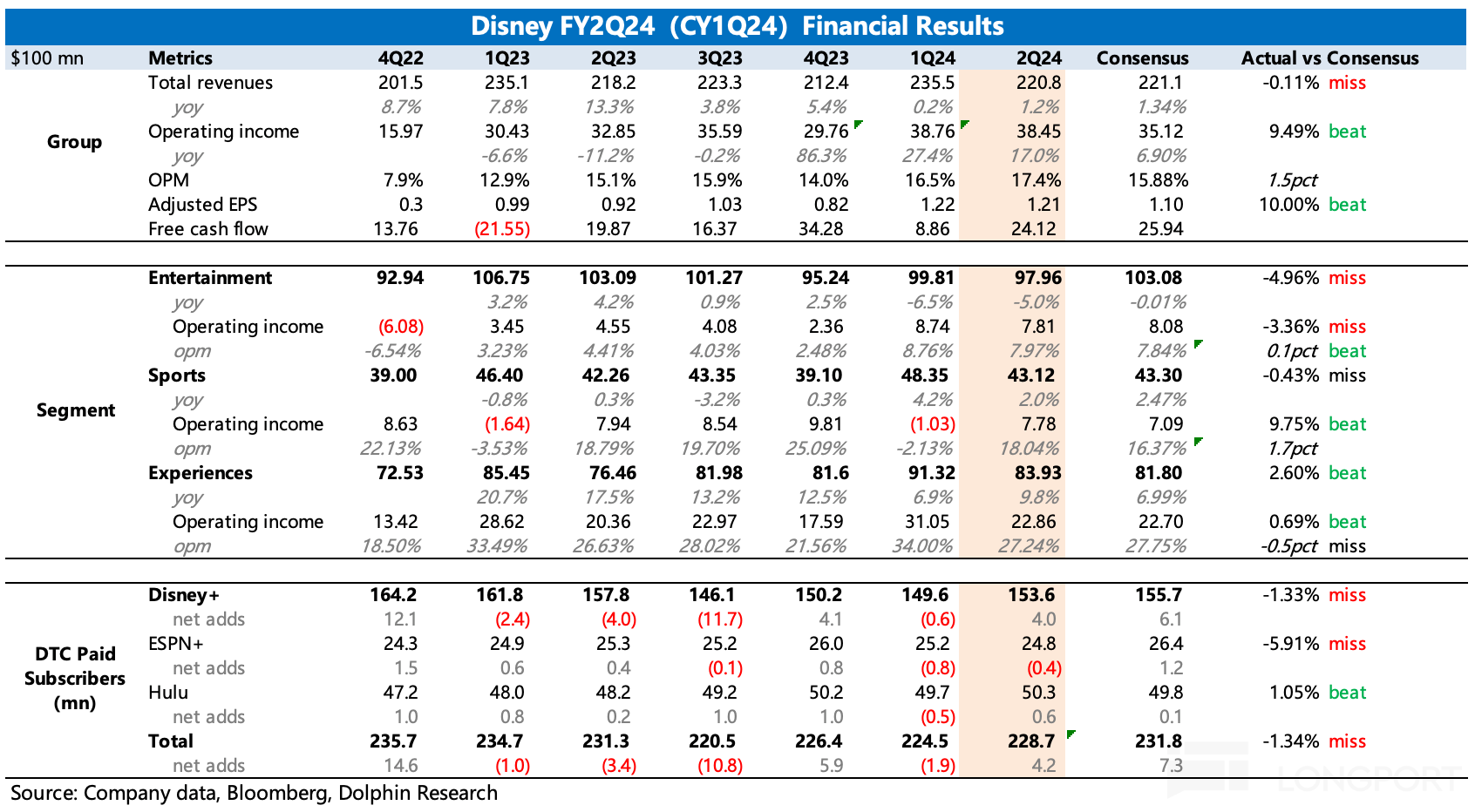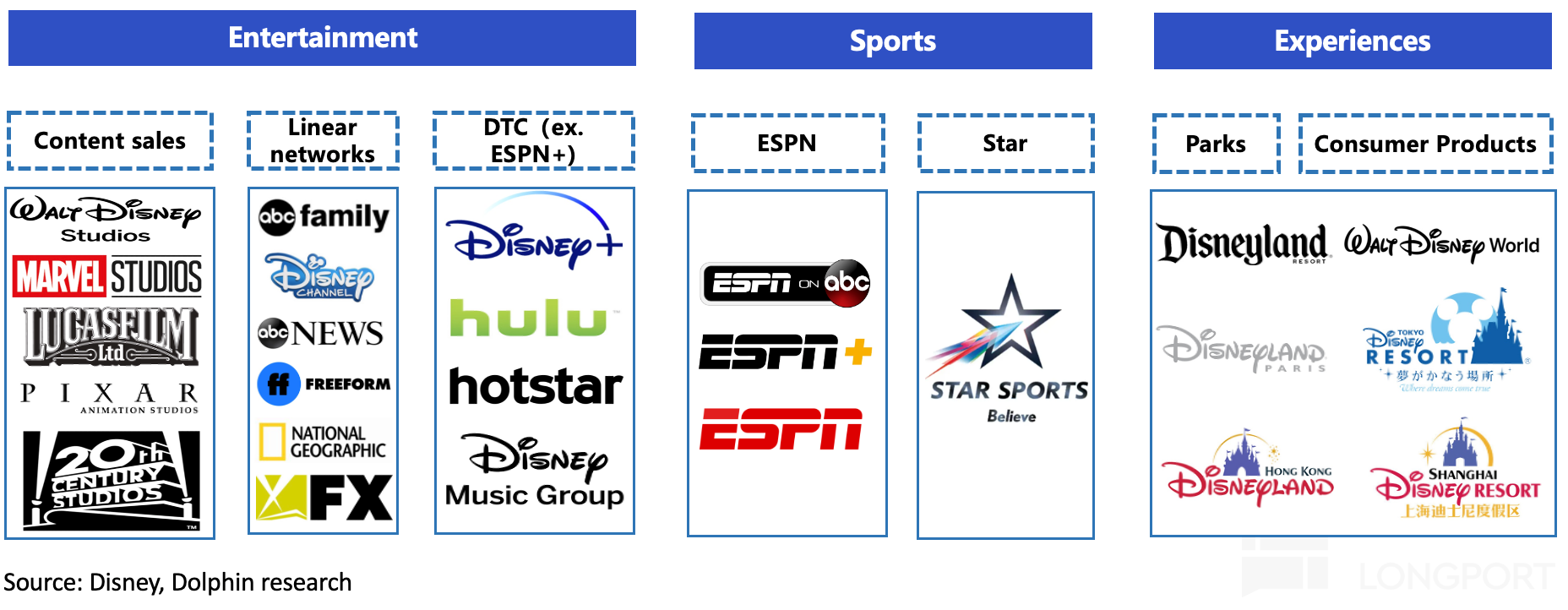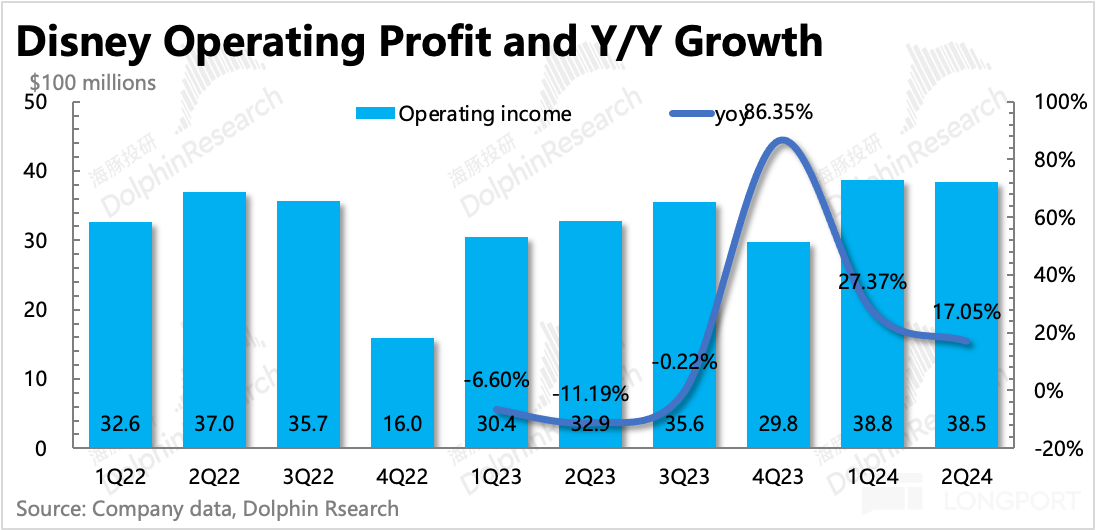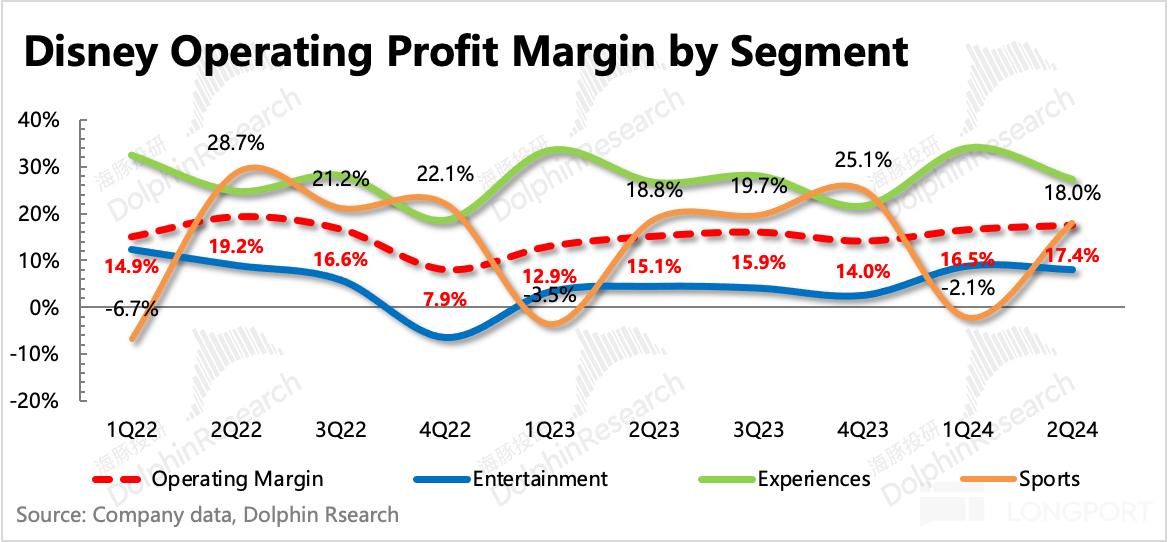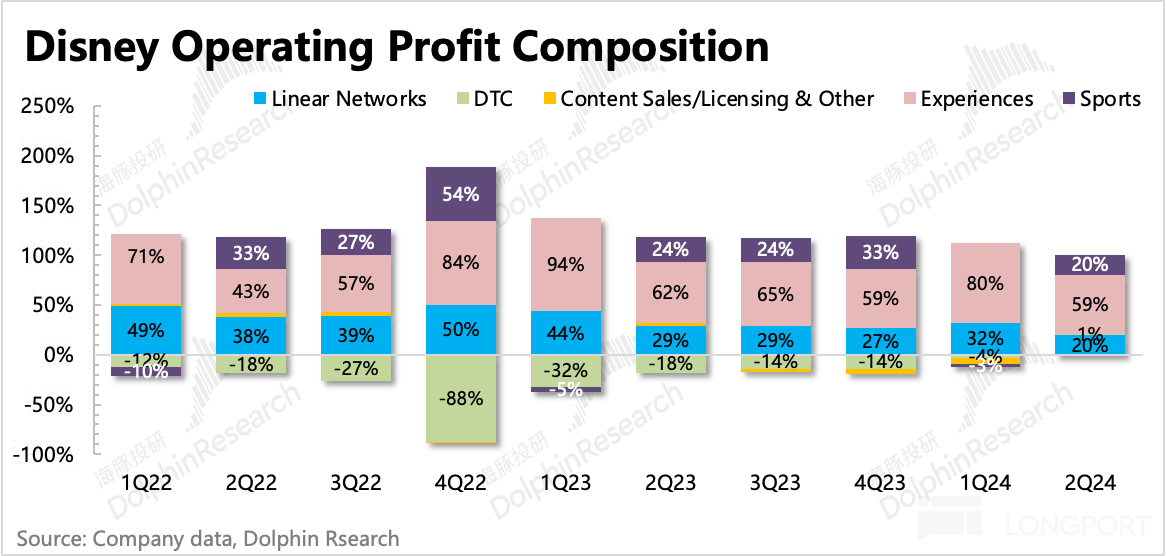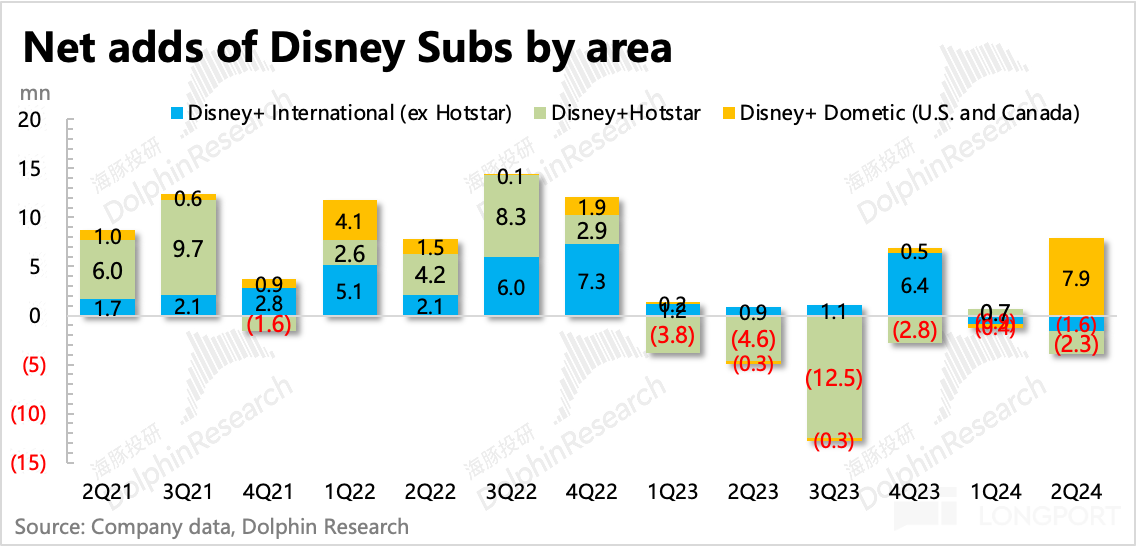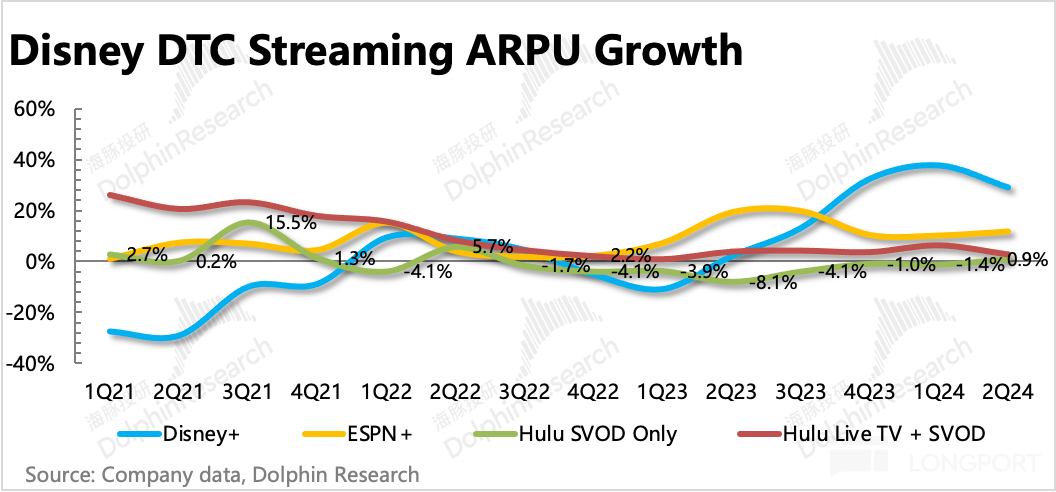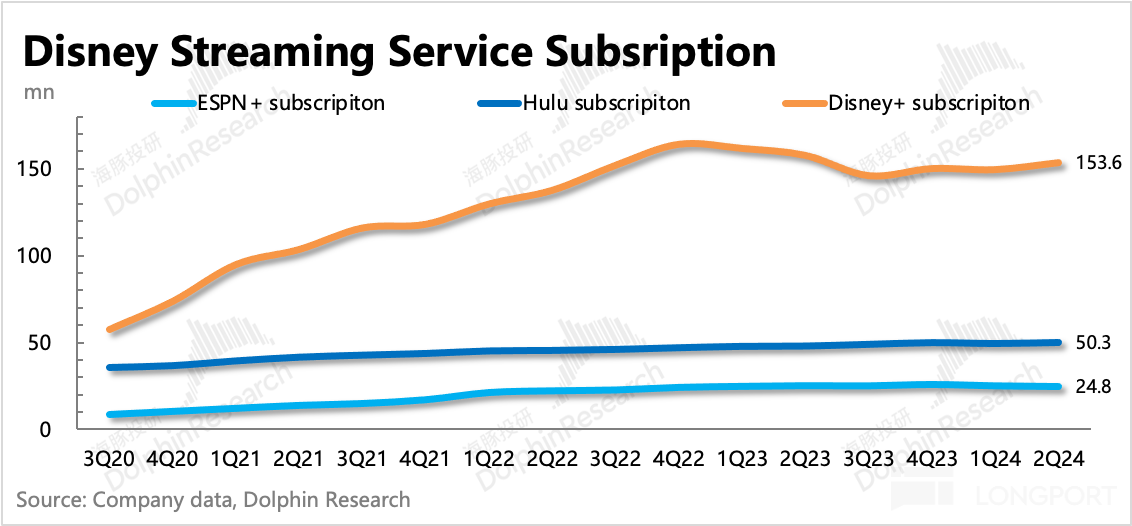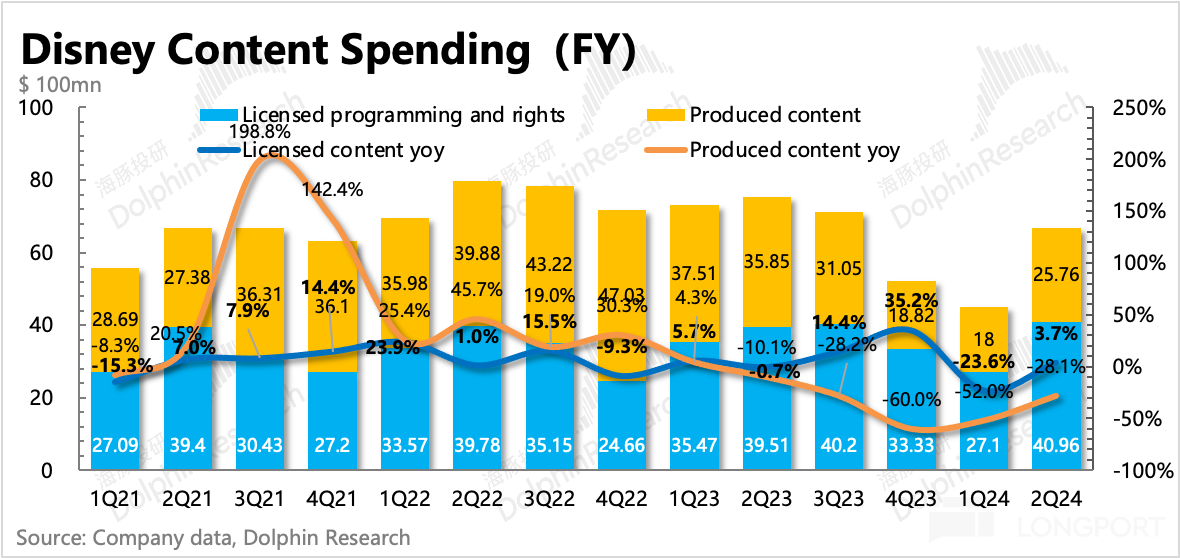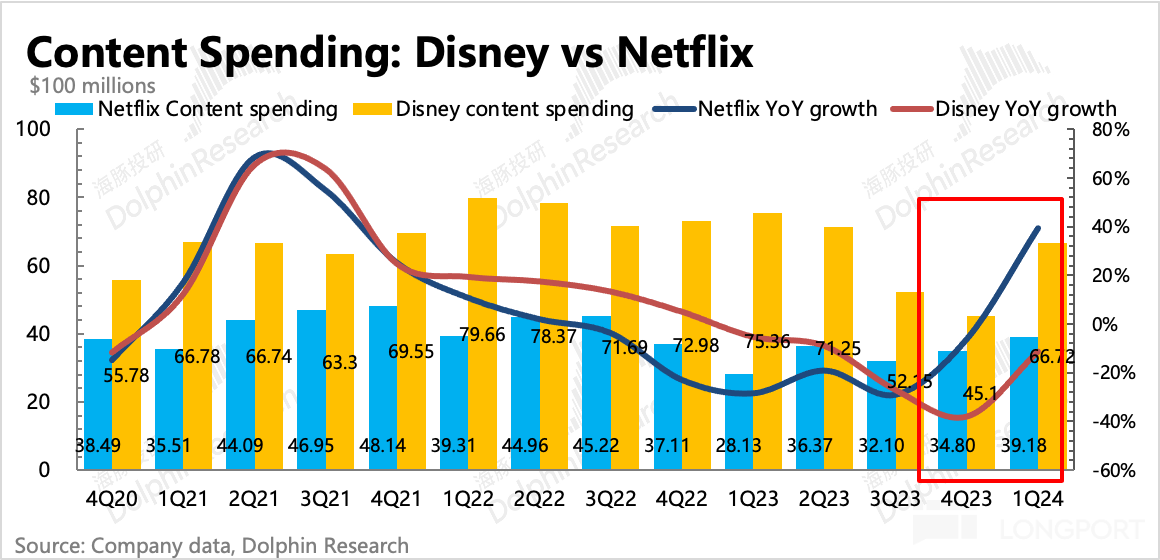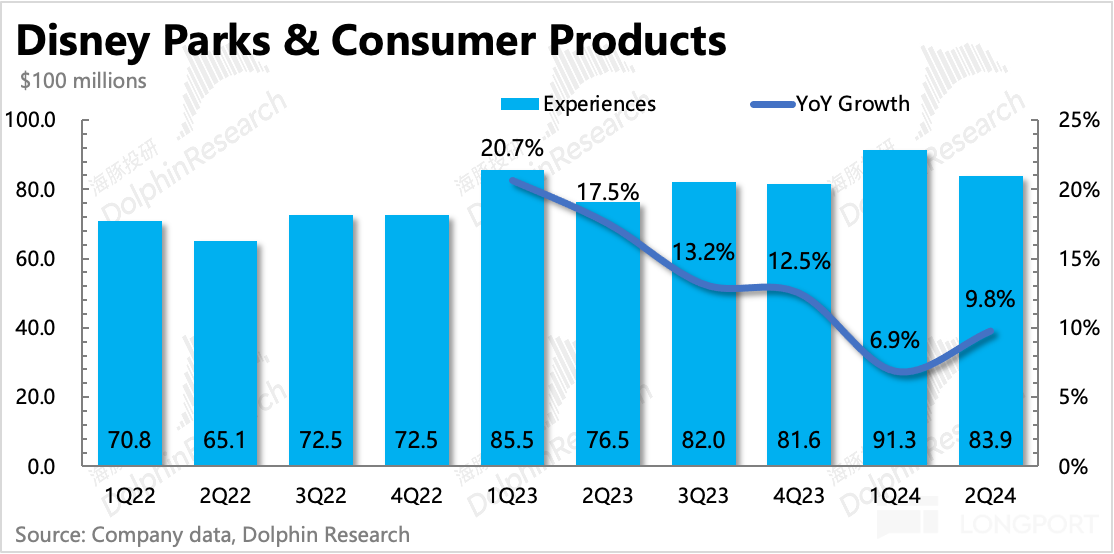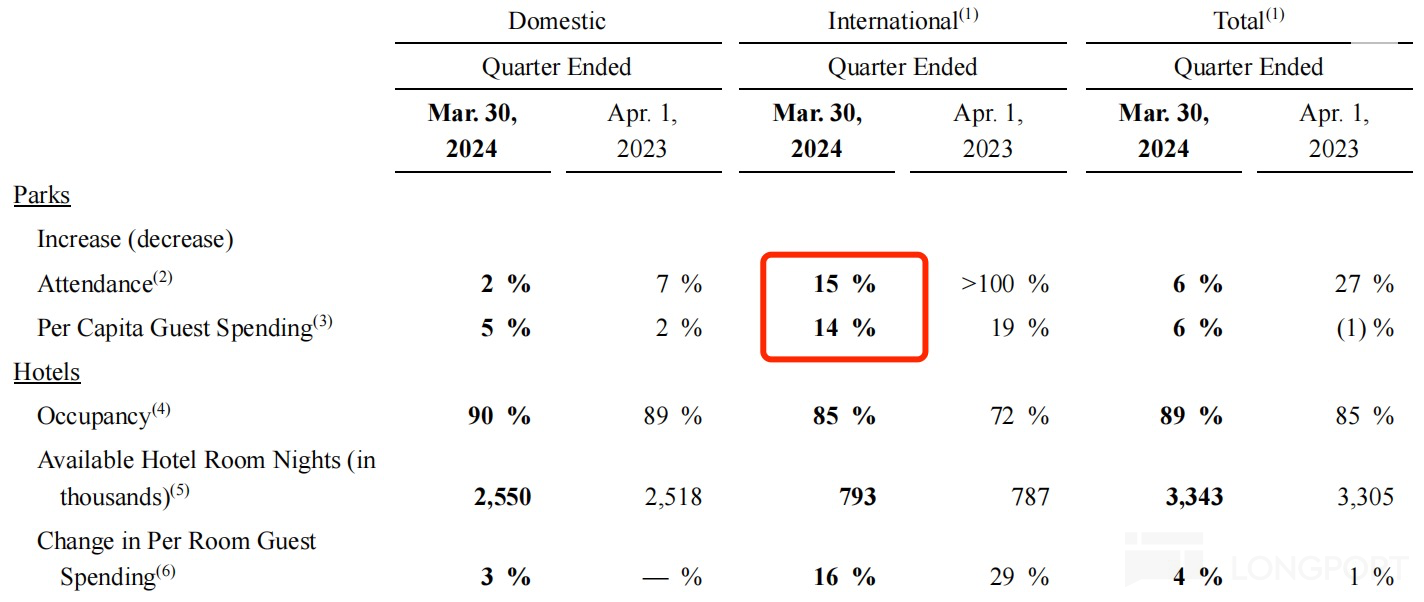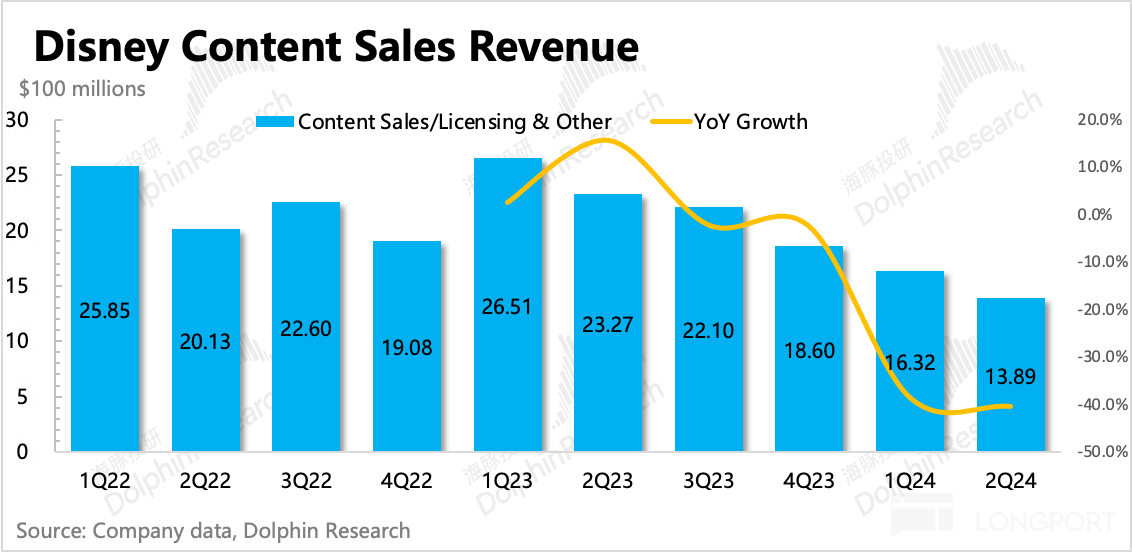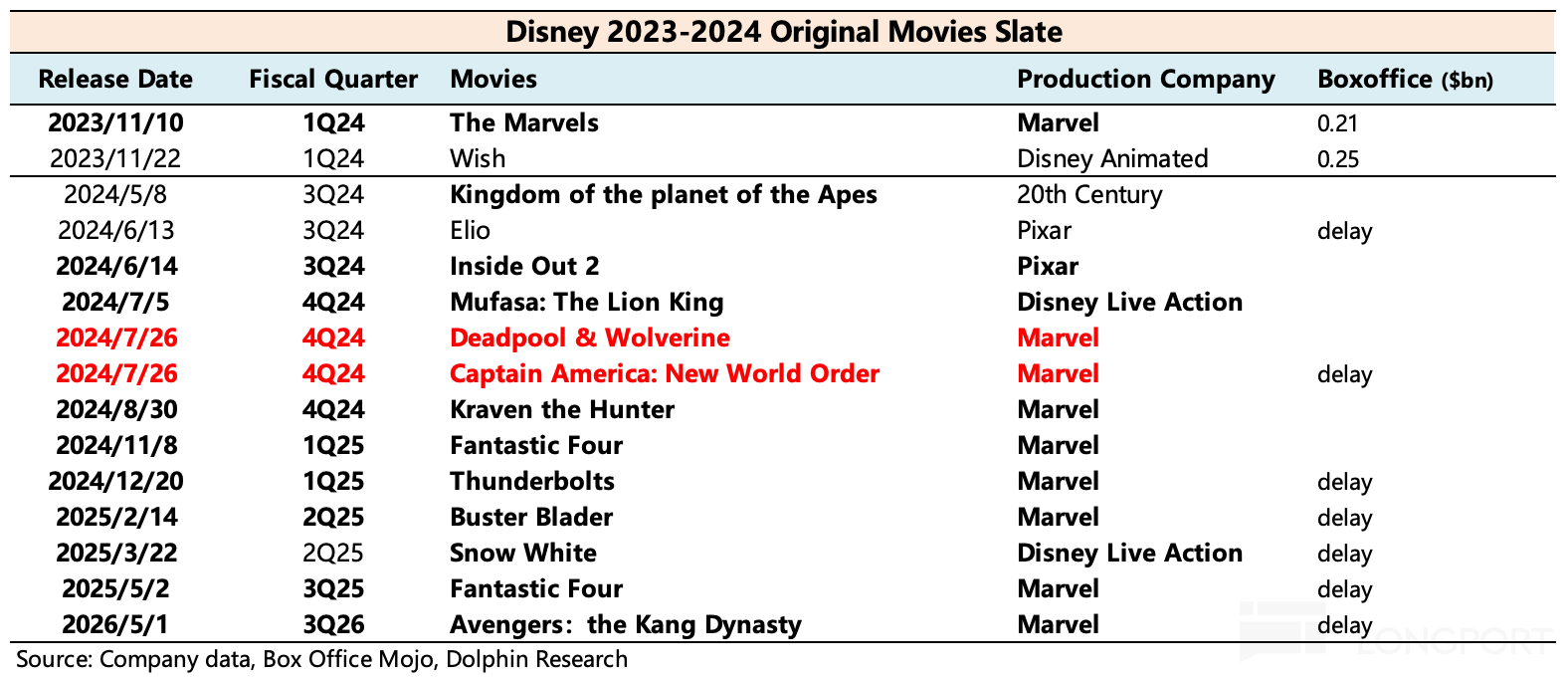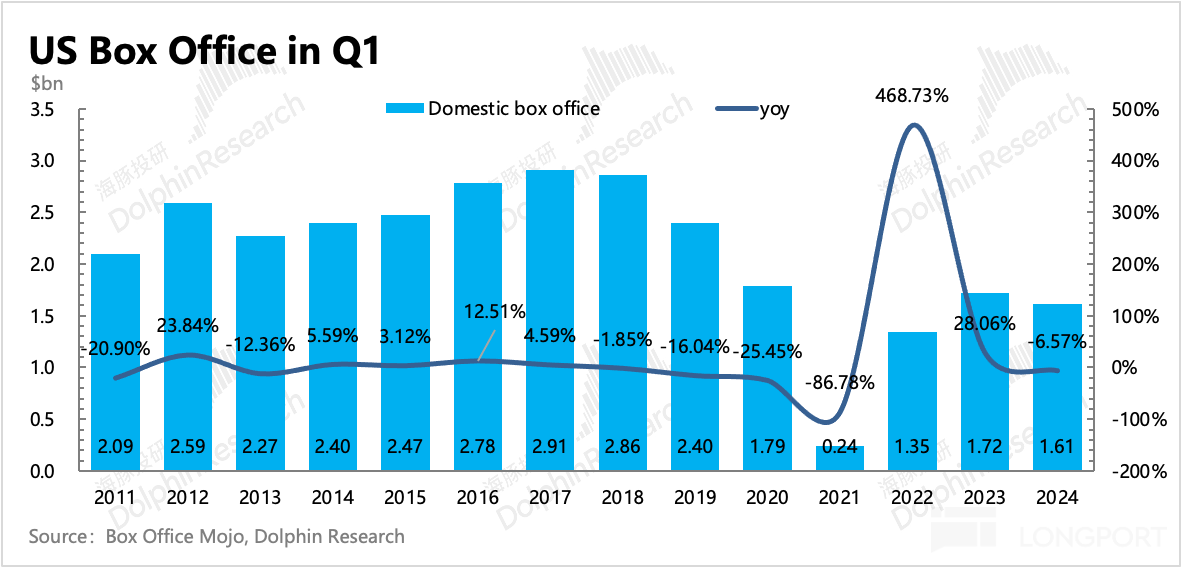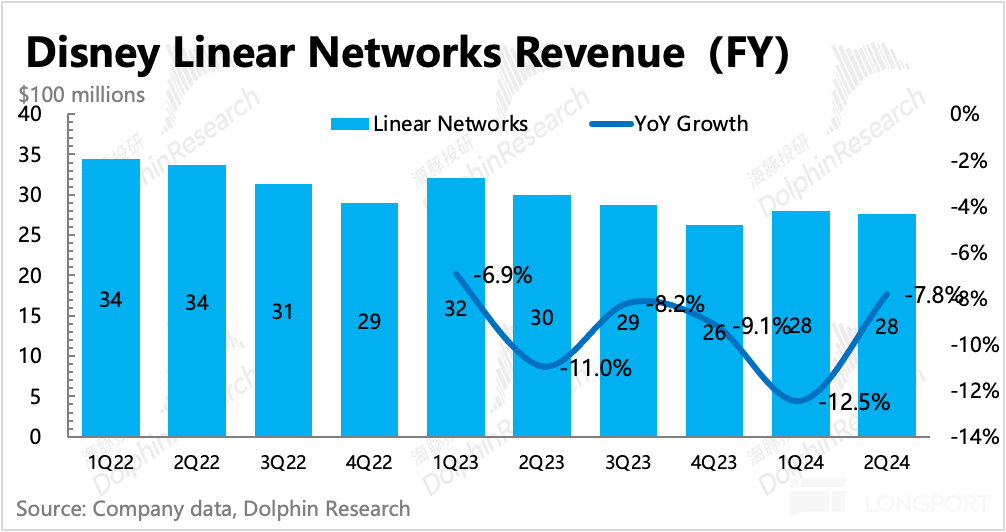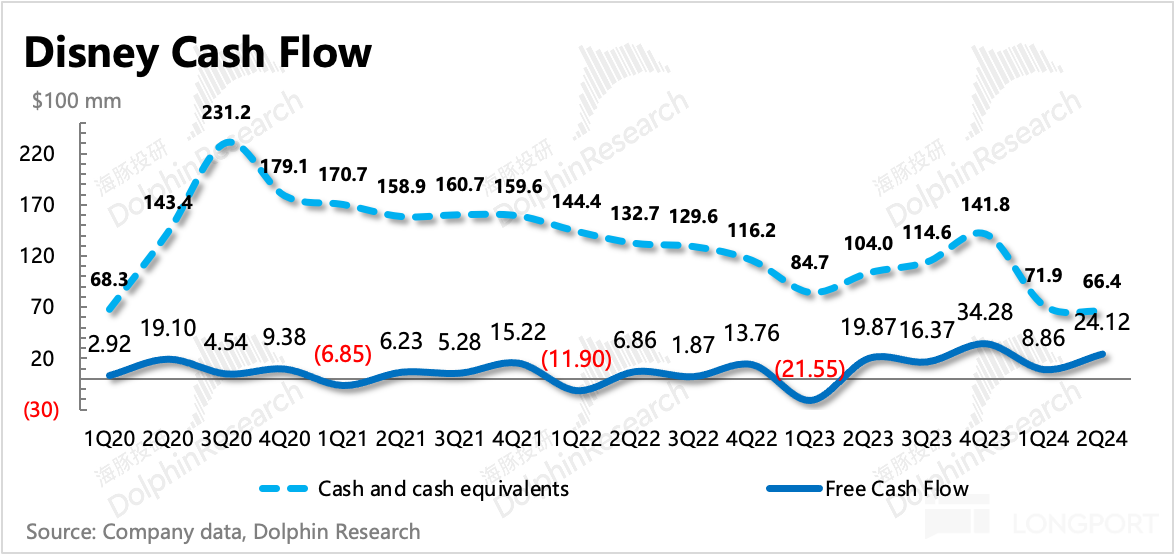
 Likes Received
Likes Received Posts
PostsDisney: Don't be scared by the downturn, hope is on the way

Hello everyone, I am Dolphin Jun!
On May 7th, US Eastern Time, after the US stock market closed, $ Disney.US released its financial results for the second quarter of the 2024 fiscal year (CY24Q1). Overall, the performance is mixed, similar to the previous two quarters, with excellent profitability but lower-than-expected revenue, which is the short-term pain mentioned in Dolphin Jun's last quarter's financial report. Currently, the market's response to this financial report seems to be somewhat negative, but upon closer examination of operational indicators and expected marginal changes, Dolphin Jun believes that the second half of the fiscal year, especially 4Q24FY, will become more positive.
Specifically:
1. Continuing to achieve the strategic goal of increasing profitability: In 2Q24FY, the company continued to implement cost reduction and efficiency improvement strategies. The DTC streaming media business, excluding ESPN+, has achieved profitability, driving a 1% improvement in the overall group's profit margin on a month-on-month basis. Ultimately, both operating profit and adjusted EPS exceeded market expectations.
Due to the good effect of reducing losses in the DTC business, the company has raised the growth rate of adjusted EPS for the 2024 fiscal year from 20% to 25%. At the same time, it still maintains the goal of turning the overall streaming media business (DTC+ESPN+Star) into profit in 4Q24FY. Although the full-year profit growth rate has been raised, market expectations are not low, so it is not considered a substantial positive.
2. Revenue growth during the pain period still under pressure: In 2Q24FY, the company's year-on-year growth was only 1.2%, slightly lower than market expectations, mainly due to pressure on cable TV and movie sales revenue, dragging down entertainment segment revenue by 5% year-on-year.
The performance of the sports business is also mediocre, as one of the company's key strategies, with no visible growth. The park business has gradually passed the high base period of the 50th anniversary celebration of Orlando Disney Park, and with the strong demand in international parks driving growth, the growth rate has rebounded, exceeding market expectations.
3. When will it return to healthy growth? Although the current revenue is not satisfactory, and the management mentioned pressure in Q3 in the financial report, from a medium to long-term perspective, Dolphin Jun believes that Disney is close to the turning point of returning to healthy growth, especially with higher certainty of growth recovery in 4Q24FY.
(1) Price increases in core streaming regions do not hinder high user growth: In the second quarter, Disney+ added a net increase of 7.9 million subscribers in the core North American region, slightly higher than the expectations of some leading institutions, but there was more user churn in Europe, America, and India, making the overall Disney+ user growth appear somewhat lackluster.
However, North America is the core region supporting revenue. In the second quarter, while experiencing user growth, Disney+ was also in a period of price increases. The simultaneous increase in quantity and price of Disney+ offset the poor revenue from Hulu and Hotstar, driving DTC revenue to still grow by 13%(2)Growth in the second half of the year is picking up: Starting from the third quarter of the 2024 fiscal year, Disney's new round of blockbuster movie cycle will kick off. Additionally, the theme park business, boosted by the 50th anniversary celebration, is expected to return to normal levels next quarter, easing the growth pressure. While cable media, which has been dragging down the group's performance, may see a slight recovery in viewership and advertising revenue during the upcoming election season.
With revenue picking up and the group's overall cost reduction and efficiency improvement cycle under Iger's leadership, profit rebound is expected to be relatively easier. Apart from short-term performance, attention is also focused on Disney's recent series of external collaborations (acquisition of remaining shares of Hulu, ESPN joint venture, partnership with Reliance, collaboration with Epic) for any new developments and potential adjustments to the management outlook.
4. Significant improvement in cash flow, $1 billion buyback executed during the quarter: After over a year of continuous internal restructuring to enhance profitability, the trend of continuous improvement in cash flow is evident. In the second quarter, free cash flow was nearly $2.4 billion, showing significant increases year-on-year and quarter-on-quarter, mainly driven by improved operating profit margins while capital expenditures remained relatively stable.
After accumulating cash on the group's balance sheet, $1 billion was spent on buybacks in the second quarter, more of a statement than a significant impact. The company maintains its cash flow expectations for 2024, with projected operating cash flow of $14 billion for the full year and free cash flow of $8 billion.
5. Strategic collaborations within and outside the industry: In the second quarter, Disney continued to actively seek external collaborations, such as establishing a joint venture company with Indian company Reliance at the end of February, aiming to expand into the Indian market. It will be interesting to see if the management will disclose any new developments during the earnings call, including progress on the collaborations announced last quarter with gaming company Epic and the joint launch of a sports streaming platform with Warner Bros.
6. Performance indicators overview

Dolphin's Viewpoint
Regarding the pressure on revenue growth in the second quarter, Dolphin has already provided some expectations in the previous quarter's review. For the short term situation in the third quarter, we anticipate some fluctuations. However, for 4Q24FY, with multiple Marvel movies scheduled during this period, along with the theme park business at a low base, cable television coinciding with the election period, viewership may return, and there may be an increase in political advertisements. Therefore, the certainty of driving overall revenue recovery will be higher.
Despite having a streaming media business, due to the complexity of the business structure and the interplay between different segments, Disney is still more of a value stock investment from a group perspective. This may require waiting for a comfortable price during key business reversals.Dolphin believes that the current situation may fall within the range of business reversal fluctuations. However, the current market value has returned to 200 billion, which is much higher than our previous expected bottom valuation of 150 billion. Nevertheless, the implied expectations and valuations are not considered high (Forward P/adj NI is 19x). If revenue returns to a relatively healthy growth level, the market will not penalize short-term loss-making businesses and businesses with low profit margins. Similar to the previous quarter's view, using the SOTP method, Dolphin believes that Disney still has the potential to return to a valuation of 230 billion, but relatively speaking, the potential return space does not seem as attractive as other growth stocks.
Below is the detailed financial report
I. Understanding Disney
As a nearly hundred-year-old entertainment kingdom, Disney's business structure has also undergone multiple adjustments, as Dolphin has detailed in "Disney: The 'Anti-aging Technique' of a Hundred-Year-Old Princess".
In the past year, there have been major adjustments at the group level, not only changing the leadership team but also altering the business structure and shifting strategic focus. Under the new business structure, it is mainly divided into three major segments - [Entertainment], [Sports], and [Experience]:
- Differences between the old and new structures?
The new structure mainly highlights the strategic position of ESPN, separating ESPN channels and ESPN+ to establish a sports business department, showing the company's emphasis.
(1) [Entertainment] business includes: original linear channels, DTC (excluding ESPN+), content sales, while disposing of some departments, integrating redundant business lines in the process, and low-revenue traditional channels.
(2) [Sports] business includes: ESPN channels, ESPN+, Star
(3) [Experience] business includes: park experiences, resorts, merchandise consumption, similar to the previous business, but due to some adjustments in the business, there are some discrepancies in specific financial data compared to before.
2. Has the investment logic changed with the new structure?
The basic logic framework remains unchanged, but there are new points to pay attention to.
(1) Firstly, this round of structural changes reflects an important strategic adjustment - content and distribution channels are no longer separated into two businesses but integrated together, with the new business structure more based on dividing according to different content.
This may solve a problem at the source - that the same content may be suitable for initial release on different channels. In the past two years, Disney was torn between whether to release hit movies on Disney+ or in theaters first. After trying simultaneous online and offline releases, it ended up dragging down the final box office performance of some hit movies. As a result, actor shares were affected, damaging Disney's cooperation with some star actors.
(2) The [Experience] business has matured over the years, with the support of a strong IP reserve, Disney's theme park business maintains a leading position, more influenced by overall consumption. Under normal circumstances, it can be seen as a stable cash flow(3) [Entertainment] Essentially, it is about the production and distribution of Disney films, including several well-known studios, traditional channels, and streaming channels, so revenue changes are mainly related to Disney's film scheduling and the overall consumption power of the film market.
The streaming media business remains the future focus of Disney in the medium to long term. However, in the past two years, it was originally a growing business that could bring incremental revenue and profits as a stable traditional business of Disney. But the competition in the front-end streaming media has intensified during the epidemic. Disney, lacking the accumulated advantage of producing original series content, has made huge investments but suffered losses.
As the two ends of the seesaw, while the development of streaming media is heating up, traditional media's old business naturally cannot thrive on its own. With the trend of decline in traditional media, for Disney, streaming media is not entirely incremental, but rather a large part is to make up for the decline of traditional channels.
(4) Disney's new favorite [Sports] business may be a new growth path that has emerged. Although ESPN has been operating within Disney for many years, sports content and related industries are also increasingly in the sights of more and more streaming media companies. For example, Netflix has mentioned several times their emphasis on sports content and increased investment.
The recent change is that Disney will join hands with Warner Bros., integrate its own Fox content, and launch a new version of ESPN online in 2025, which is essentially doubling down on the bet on the sports track.

Second, continue to achieve the strategic goal of profit improvement
Reducing the losses of streaming media to bring overall profitability to the group has been the first goal that Iger has been emphasizing since his return in 2022.
The second-quarter streaming media (excluding ESPN+ and Star) has shown excellent results in reducing losses and has already achieved positive profitability, compared to struggling with a loss of 500 million in a single quarter last year. This nearly 600 million profit increment, corresponding to nearly 600 million increase in the group's overall operating profit year-on-year, has also increased the profit margin to 17.4%.

However, looking at it in detail, other businesses are not maintaining the same frequency of fluctuations, but rather showing a seesaw trend. Among them, cable television and film sales are rapidly declining in profitability under pressure on revenue, the park business is maintaining a stable domestic profit margin, and with the strong recovery of income in international regions and strong demand for cruises, the entire experience service sector's profit margin continues to improve.
From a profit contribution perspective, the park business remains the main force, followed by cable television and sports business. But the good news in the second quarter is that film sales and DTC are no longer clearly dragging down.


! Looking ahead, the cost reduction and efficiency improvement strategy will still be strictly implemented at least for this year. The company maintains its cash flow expectations (net cash inflow from operating activities of $14 billion, free cash flow of $8 billion) and increases profit growth guidance (adjusting EPS growth from 20% to 25%). Dolphin expects that there will be an increase in operating-related investment expenditures in the 2025 fiscal year, but considering Iger's style, at least before his retirement (by the end of 2026), the entire Disney group will continue to maintain a high-efficiency operational strategy, with profitability remaining the top KPI.
III. DTC: Growth of core regional users
In the second quarter, Disney+ added 7.9 million net users in North America, which is still in a period of price increases, so the value of this growth is still significant. However, there continues to be a decline in Europe and India.


By the end of this quarter, Disney+ had 153.6 million subscribers, ESPN+ had 24.8 million, Hulu had 50.3 million, totaling 228.7 million subscribers. Although the company's current focus is on streaming media, it still focuses on reducing losses in the streaming media business. However, since the last quarter has already disclosed growth expectations (expected growth of 5.5-6 million in 2024), with Disney+ and Hulu already profitable this quarter, the company's demand for user growth will also increase accordingly. It is recommended to pay attention to whether there will be adjustments to user growth expectations in the conference call.

Content spending in the second quarter has shown a growth trend, increasing from $4.5 billion in the first quarter to $6.7 billion in the second quarter. The planned expenditure of $25 billion mentioned at the beginning of the year indicates that content investment in the second half of the year will accelerate.

During the same period, Netflix's content investment also indicates a cyclical restart, with growth reaching 39%. The wave of content investment and production is expected to be released at the end of this year and next year

Four. Theme Parks: Overseas High Heat Continues, Domestic About to Pass High Base
In the second quarter, the revenue of theme parks and consumer goods reached 8.4 billion, a year-on-year increase of 10%. Although still in a high base period (California Orlando Disneyland's 50th anniversary celebration will continue until April 2023), the growth rate has rebounded compared to the first quarter. It is expected that in the second half of the fiscal year, as it moves out of the base disturbance, the growth rate will further recover. Internally, the growth rate of the park business in the second quarter was 11%, while consumer goods reversed the downward trend and returned to positive growth.

Although the domestic parks have seen relatively little increase in visitor numbers, per capita consumption continues to grow by 5%, driving a 7% increase in revenue for domestic parks.
International theme park demand remains strong. Despite coming out of the high base period of the epidemic last year, this year's second-quarter revenue was still able to increase by 29% year-on-year. The growth rate of visitor numbers has slowed down, but per capita consumption has remained stable. Hong Kong and Shanghai Disneyland parks have made significant contributions to growth. In November last year, Hong Kong introduced the Frozen-themed area, and Shanghai introduced the Zootopia-themed area in December, enriching the park experience further as the core driver of demand growth.

Five. Movie Gap Period, Entering a New Cycle in the Second Half of the Fiscal Year
In the second quarter, Disney did not release any movies, coupled with the difficult trend of declining family entertainment revenue, resulting in a 40% year-on-year decline in film and television content revenue.
Looking ahead to the second half of the fiscal year, in the current movie schedule, there are many Marvel blockbusters (a wave of products that were previously delayed) set to be released after 3Q24FY, which is expected to reverse the current embarrassing low period.


The shortage of film content is not unique to Disney. Over the past three years, the U.S. and even the global film market has been affected by factors such as the epidemic and strikes, leading to a shortage of supply. The industry's box office scale in 2023 is far from recovering to the normal level of 2019. Although offline cinemas are also slightly shrinking with the development of streaming media, the main impact is still the scarcity of released films

Since the beginning of 2024, the Q1 box office revenue in the United States has declined by 7% year-on-year, mainly due to the short-term film supply impact of last year's strike.

In the second quarter, cable television was affected by the trend of cord-cutting, with revenue still declining year-on-year, but the rate of decline has slowed to 8%. Subscription revenue saw a slightly larger decline. Although advertising revenue is still declining, the decline has significantly slowed compared to the previous quarter. Dolphin believes that from the second half of the fiscal year to Q1 of fiscal year 2025, which coincides with the critical period of the election, advertising revenue is expected to continue to recover.
In the second quarter, free cash flow net inflow was nearly 2.4 billion yuan, continuing to improve the cash flow situation while remaining stable in profit release and investment. As of the end of the second quarter, the company had 6.7 billion yuan in cash, 6.8 billion yuan in short-term borrowings, with net cash basically at zero.
With further increase in profit requirements by management, Dolphin is not particularly worried about Disney's cash flow. The target of 8 billion yuan in free cash flow for 2024 remains unchanged, representing a 63% year-on-year growth compared to 2023.
However, as subsequent content investments enter a new growth cycle, it may affect the pace of further improvement in cash flow. Nevertheless, compared to short-term cash flow saved by reducing investment, we hope to see the issue of content shortage resolved, traditional content businesses such as movies reducing drag, and at the same time, we hope to see a clear expansion trend in streaming media users with a rich content library.
Due to a large amount of operating data not disclosed in the performance report, it is recommended to pay attention to the complete financial report or directly check the "Deep Data" section of the Longbridge app.
Dolphin "Disney" Related Articles
Earnings Season
February 8, 2024 conference call "Disney: Crackdown on Free Account Sharing to Begin This Summer (Conference Call Summary)" LinkFinancial report review on February 8, 2024: "Disney: Still in pain, but the turnaround is on the way"
Conference call on November 9, 2023: "Impact of Disney+ price increase on user payments will be reflected in the next quarter (Disney 4Q23FY conference call minutes)"
Financial report review on November 9, 2023: "Disney: Dawn is breaking, but there is still a disturbance"
Conference call on August 10, 2023: "Disney: More open, yet more cost-effective (3Q23FY performance conference call minutes)"
Financial report review on August 10, 2023: "Disney: Where is the bottom in this 'crisis' moment?"
Conference call on May 11, 2023: "Softness in streaming subscriptions and advertising may continue into Q4 (Disney 2Q23 conference call minutes)"
Financial report review on May 11, 2023: "Disney: Sacrificing growth for profit, how to balance the conflicting demands?"
Conference call on February 9, 2023: "The future belongs to streaming, but it needs to be operated reasonably (Disney 1Q23FY conference call minutes)"
Financial report review on February 9, 2023: "The legend returns, Disney is starting to change"
Conference call on November 9, 2022: "Disney: Focusing on profit, sourcing and saving (4Q22 conference call minutes)"2022 年 11 月 9 日财报点评《巨头轮流锤,百年迪士尼也撑不住了?》
2022 年 8 月 11 日电话会《迪士尼:线下需求火热,调低中长期流媒体用户指引(3Q22 电话会纪要)》
2022 年 8 月 15 日《迪士尼:主题公园 “高热” 不散,流媒体跑步扩张》
2022 年 5 月 12 日电话会《迪士尼:下半年内容强劲、公园景气持续,降低内容授权、亚洲公园关闭是不利因素(2Q22 电话会纪要)》
2022 年 5 月 12 日财报点评《迪士尼:传统业务加速利润释放,奋力输血流媒体》
2022 年 2 月 10 日电话会《逐步进入内容周期,管理层对增长目标信心满满(迪士尼电话会纪要)》
2022 年 2 月 10 日财报点评《迪士尼:流媒体增长恢复荣光,更漂亮的是主题公园》
2021 年 11 月 11 日电话会《疫情干扰,迪士尼内容周期且看 2022 财年下半年(电话会纪要)》
2021 年 11 月 11 日财报点评《流媒体增长拉垮,迪士尼的漫漫转型路也难走了?》
深度
2022 年 6 月 1 日《迪士尼:流媒体泡沫刺破,回归主题公园本命》
2021 年 10 月 10 日《迪士尼:百岁公主的 “驻颜术” On October 15, 2021, "Can Disney, who keeps "dreaming", have a "dreamy valuation"?" was published.
Risk Disclosure and Statement of this Article: Dolphin Research Disclaimer and General Disclosure
The copyright of this article belongs to the original author/organization.
The views expressed herein are solely those of the author and do not reflect the stance of the platform. The content is intended for investment reference purposes only and shall not be considered as investment advice. Please contact us if you have any questions or suggestions regarding the content services provided by the platform.

